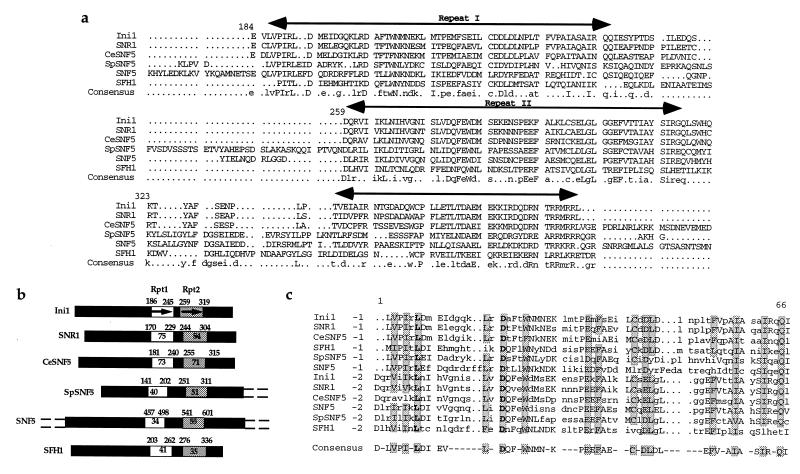Figure 1.
Alignment of proteins/ORFs with homology to Ini1 protein. (a) Alignment of highly conserved regions of six protein/ORFs, Drosophila protein SNR1, C. elegans ORF R07E5.3 (CeSNF5 protein), S. pombe ORF encoding C2F7.08C protein (SpSNF5), and the two yeast proteins, SNF5 and SFH1. The alignment was performed by using the program multialign. The three highly conserved regions are indicated by horizontal arrows. Consensus sequence is indicated at the bottom. The first amino acid residue of Ini1 in each lane is numbered. (b) Graphical representation of six Ini1 homologues displaying the two repeat motifs. The name of the protein is indicated on the left. The two repeats are indicated by thick arrows, and the highly conserved regions that contain the two repeats are indicated by boxes. Empty box, repeat 1 (Rpt1) and shaded box, repeat 2 (Rpt2). The numbers at the beginnings and ends of the boxes represent the position of the amino acid residue at each edge of the region. Percentage identity of primary sequence between Ini1 and a given protein within the particular repeat is indicated inside the boxed area. The N-terminal and C-terminal glutanine- and proline-rich regions of SNF5 and SpSNF5 are indicated by dashed lines. (c) Alignment of the sequence of two repeat motifs with each other and their consensus sequence. The repeats, 1 and 2 of six Ini1-related proteins, were aligned by using pileup program in GCG and displayed by using the pretty program. Consensus sequences of the repeat motif, determined by using the plurality of 6 of 12 identical or conserved residues, is indicated at the bottom. The invariant residues are indicated by bold letter. Highly conserved and invariant residues are indicated by shading.

